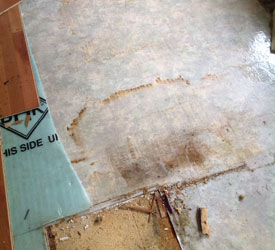Common Root Causes Of Water Damage in a Bathroom
Common Root Causes Of Water Damage in a Bathroom
Blog Article
The article down below in relation to Looking for Signs of Water Damage in the Bathroom is exceedingly enlightening. Don't bypass it.

The washroom is incredibly prone for damp accumulation and also prospective water damage as a result of the regular use of water in it. This write-up uses easy inspection strategies to assist spotting water damages dangers.
The frequent use water in the shower room makes it incredibly vulnerable for damp accumulation and also prospective water damage. By evaluating it frequently, you can lower water related problems.
The following collection of evaluations is easy to do and need to be done once in every 3 months in order to keep your bathroom healthy as well as to prevent possible water damages caused by the bath tub, the shower, pipe joints and also plumbing, sinks, cupboards, and the commode
Do not disregard performing these examinations as well as be thorough while doing them. Keep in mind that these basic evaluations can conserve you a lot of cash by supplying early indicators for water damage
Bath tub and Shower
The shower and also bathtub call for special focus as well as maintenance. Inspect the tiles as well as change if broken. Make sure that there is no missing cement between the floor tiles. Inspect and change cracked caulking at joints where the wall surfaces meet the flooring or the bath tub. Clogged drains pipes and also pipes troubles will stop the bathtub from drying and also may suggest serious issues under the bathtub. Talk to a professional right away to avoid architectural damage. Focus on stainings or soft areas around the tub wall surfaces as they may suggest an inner leakage.
Plumbing
Signs for water damage are difficult to identify because many pipelines are mounted inside the walls.
Pay special interest to floor covering and walls wetness and also stains as they may suggest an unseen plumbing problem. Check wetness degrees in adjacent rooms as well.
Sinks as well as Cabinets
Sinks and also closets are exposed to moisture as well as moisture day-to-day and also are often neglected. Check consistently under the sink and also on the countertop above it. Repair any drip in the trap as it may recommend drainpipe troubles. Check out the sink, slow draining pipes may indicate a blocked drain. Replace sink seals if they are split or loose.
The Bathroom
The bathroom is a prone water junction. Inspect the water lines as well as look for leakages around the bathroom seat, in the pipe, and also under the water container. If you identify any kind of indicators of dampness on the flooring around the commode, look for leakages in the toilet edge and also container seals.
Realize that hanging commode dish antiperspirants boosts the opportunities for obstructions.
Water Damage Signs In The Bathroom To Avoid Cleanup
Musty smell
This is one of the easiest signs to catch because musty smells are so odorous. The damp, earthy, moldy smell should be a big red flag. The smell will develop when moisture gets trapped in surfaces, and begins to facilitate mold growth. Leaking pipes under cabinets, inside walls, and behind shower fixtures will cause moisture to stay trapped and not dry, which will lead to mold growth and spread. As soon as you notice any musty smells in your bathroom, have it checked for hidden water damage and cleanup signs.
Visible mold
If the smell isn’t there to give it away, sometimes you will actually see mold growth. Finding mold in your bathroom is a serious problem, because mold is very harmful to your health. By the time mold growth is visible, it also means that water damage has already occurred and been present for some time. The only way the mold problem can be resolved is to find the source of the moisture and get it stopped. To safely and adequately remove mold, you need to have professionals handle the remediation. Do not waste any time in getting mold problems addressed, fixed, and sanitized so that you can protect you and your family from the many respiratory symptoms caused by mold exposure.
Damaged floors
Bathroom floors should be able to withstand some exposure to water while still remaining in good condition. However, when excess exposure or water leaks occur, they will begin to damage even the most water-resistant flooring. If you notice any cracking, bubbling, staining, or warping on your bathroom floors, there is probably a water leak somewhere causing the distortion. If you notice areas of the floor have become softer, or even have a spongy feeling, there is probably damage to the subfloor. Subflooring is typically made up of plywood. When plywood is exposed to water or moisture, it will absorb it. Once it has become saturated, the weight of the excess water will cause the wood to swell and soften. Check the floors in your bathroom frequently to catch any of these sings before they lead to damaged subflooring.
Changes on walls
When water leaks behind walls, it will cause changes in the drywall. Peeling plaster, blistering paint, and soggy wallpaper are all good indicators that excess water is building up behind the wall. Water leaking behind drywall will cause it to swell and be soft to the tough. If you start to notice gaps along the trim of your walls, or where tile meets the wall, it could also be a strong indicator that there is a leak behind the wall. Any changes, distortion, or damage on the walls should be evaluated as soon as you notice it to prevent further water damage and cleanup.

I'm just very serious about How to Repair and Prevent Bathroom Water Damage and I'm hoping you appreciated our article. Liked our piece? Please share it. Help others find it. Many thanks for your time. Visit us again soon.
Book A Service Call Report this page